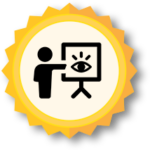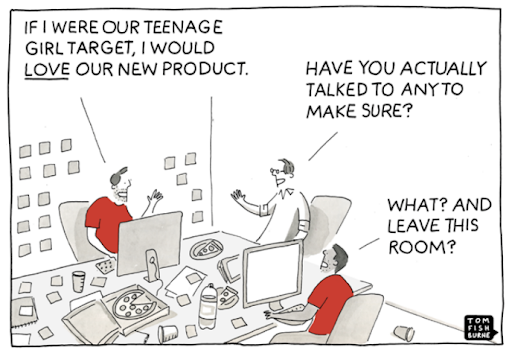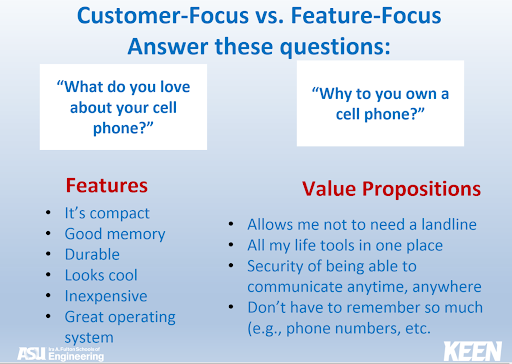Entrepreneurial Mindset Strategy: Customer Discovery
 Overview and Introduction: The WHAT and WHO
Overview and Introduction: The WHAT and WHO
Customer discovery is the process of gathering information about potential customers, their needs, and the problems they face in order to validate the assumption about a product or service. It is a crucial step in the design process and allows students to understand their target market, identify potential customers, and gain insights into customer needs and preferences. This is important so that engineers can consider their approach and understand diverse perspectives and the pain points of their customers.
Customer Discovery is a term coined by Steve Blank as part of the Lean Startup Methodology. The process of customer discovery typically involves conducting interviews, surveys, or focus groups with potential customers to gather information about their pain points, needs, and how they currently solve those needs. This information can be used to validate or invalidate assumptions about solution or product, and to make informed decisions about engineering design.
Customer discovery is [1, 2]:
- Gaining a deeper insight into a customer or the market
- Actively listening to a user or decision maker
- Looking for clues that help confirm or deny your assumptions and ideas
Customer discovery is not [1]:
- Asking a customer to design the solution
- Selling the design or demonstrating its features

 Implementation and Timing: The WHEN, WHERE, and HOW
Implementation and Timing: The WHEN, WHERE, and HOW
Customer discovery is important throughout the learning and teaching process. However, it is most important before students begin prototyping a solution or minimal viable product (MVP). Ongoing interviews throughout the design process will also allow students to ensure that they are meeting their users needs. Customer discovery is about gaining much deeper insight into a client, stakeholders, or a market.
Customer Discovery Core Questions [1]
-
- What is the problem?
- Who do you want to learn from?
- What do you want to learn?
- How do you make sense of what you learn?
Plans for Implementation
- Talk to humans. Customer discovery is at its core talking to people – real, potential customer segments, sponsors, or stakeholders. Interviews can be done face-to-face or virtually, but if they are able to connect for a short amount of time with a real customer to understand their problem, then students can gain valuable insight. Encourage students to get creative in finding their interview subjects – don’t just ask friends and family who may be an easier audience to access. Share the 10 Dos and Don’ts of talking to humans.
-
-
- Tip: Students should share that they are students/researchers. This may give them an advantage to motivating their customers to talk with them if it is part of a learning process.
-
- Focus on behaviors. Being told an idea is cool is not useful for your students; they should focus on gathering data and asking questions on client behavior which validates a client’s willingness to invest in a solution [1]. The goal is to listen, not to pitch an idea for feedback. Here are several questions from ASU Entrepreneurship + Innovation:
-
-
- “Tell me about __a problem__.”
- “What part of that is most stressful/ annoying?”
- “What’s the biggest problem or annoyance when it comes to __ ?”
- “How have you tried to do to address [solve] that?”
-
- Focus on insights, not validations assumptions. The goal of speaking with customers is not to validate ideas around a solution, but rather to gain a deeper understanding of a pain point or problem.
-
-
- Tip: Students should ask open-ended questions – start with what, how, or why.
-
- Focus on value, not features. Each need that an innovation fills or pain point that is alleviated is called a value proposition [2]. Students should be value-focused and customer-focused in their customer discovery, rather than feature-focused. See an example of this in Figure 2.
- Modify and start small. If having students interview customers or clients is not feasible, consider other customer discovery activities that encourage their entrepreneurial mindset. A few ideas:
-
- Online research and customer reviews: You may have your students simply research the marketplace. Conducting online research to understand customers’ pain points and needs, studying their behavior on the web, and looking at customer reviews can give students valuable insights into customer preferences and needs.
- Observation: Observing people in their natural environment can provide insights into how individuals use products or services. Students may observe customers in an appropriate setting and identify unmet needs.
- Brainstorm for peer feedback. Students can practice communicating the problem and drafting questions for a client with their peers. Groups can present to one another to receive feedback. See Ryan Meuth’s customer discovery activity in his KEEN card, “Why are we making this?” Customer Discovery in a Capstone Course

 Rationale and Research: The WHY
Rationale and Research: The WHY
By participating in customer discovery activities, such as conducting interviews and online research, students learn how to identify and validate assumptions about an idea, how to identify customer pain points, and how to gather information that can be used to improve their innovations. Customer discovery in engineering education helps students understand the importance of meeting the needs of end users in the engineering design process. Additionally, customer discovery can help students to develop skills such as communication, problem-solving, critical thinking, and applying an entrepreneurial mindset, which are essential for success in the engineering field. Finally, customer discovery can be used to expose students to the aspects of product development, such as market research, user research, and human-centered design. It also helps to bridge the gap between academic learning and industry practices.

 Additional Resources and References
Additional Resources and References
- Customer Discovery Canvas Module by Gary Lichtenstein (Canvas Commons): This module contains resources for teaching Customer Discovery. It includes a slide overview, link to a YouTube Customer Discovery demo, a 3-part interview with Dr. Brent Sebold on what customer discovery is and how to do it, 8 tips for conducting customer discovery interviews, and a quiz.
- Value Proposition by Ming Zhao (Dropbox): This assignment example contains a value proposition activity where students were asked to interview their project sponsors. It includes a template for students to formulate their value proposition.
- 10 Dos and Don’ts of Talking to Humans
- ASU E+I Just Start Guide: This guidebook is filled with activities to help students reflect on their ideas and set specific goals. Prompts focus on entrepreneurial mindset, problem solving, a customer discovery activity, and helping students showcase their strengths.
Exemplar KEEN Cards
- Shawn Jordan, customer discovery event with a panel
- Amy Trowbridge & Haolin Zhu, Course Modules Providing Interdisciplinary Perspectives on the Grand Challenges for Engineering (Module 1 includes a unit on Customer discovery, needs analysis, and opportunity identification)
- Andrea Kwaczala (Western New England University), End User Feedback – The Empathy Map
Like these resources? See a full list of entrepreneurially minded content here, created by Robust Entrepreneurially Minded Leaders (REMLs) at ASU.
Customer Discovery and Development Resources
ASU Resources
- What is Customer Discovery and Development?
- Lecture video playlist: https://bit.ly/2LMPQnf
- Contents: Five mini-lecture videos
- Length: Approximately 25 minutes in total
- Audience: Originally developed for a Global Freshman Academy course, but applicable to all levels of learners.
- Customer Discovery and Development Slide Decks
- ASU Customer Development Slide Deck for Global Freshman Academy: https://goo.gl/1g6gu7
- ASU Customer Discovery Slide Deck: http://links.asu.edu/CustDev
- ASU Customer Development Slide Deck: https://goo.gl/AJNXFD
External Resources
- Getting Out of the Building: Customer Development
- Link: https://www.entrepreneurship.org/learning-paths/the-lean-approach/getting-out-of-the-building-customer-development
- Contents: 6-minute lecture video
- Link: https://www.entrepreneurship.org/learning-paths/the-lean-approach/getting-out-of-the-building-customer-development
- 8 Tips For Conducting Interviews That Deliver Relevant Customer Insights
- Link: https://blog.strategyzer.com/posts/2015/11/8-tips-for-conducting-interviews-that-deliver-relevant-customer-insights
- Contents: Assigned reading (blog post)
- (How to Conduct) Customer Development Interviews
- Link: http://blogs.oregonstate.edu/thestartupadvantage/2015/01/22/customer-development-interviews/
- Contents: Assigned reading (blog post)
- 7 Common Customer Development Mistakes and How to Avoid Them
- Link: https://www.huffingtonpost.com/michael-b-fishbein/7-common-customer-develop_b_4311877.html
- Contents: Assigned reading (article)
- Work With Customers Before You Write Any Code (or Build Your Prototype)
- Link: https://www.youtube.com/watch?v=0wujokikyWo
- Contents: 13-minute case study video
References
[1] G. Constable, Talking to Humans. Giff Constable, 2014.
[2] G. Lichtenstein, Customer Discovery Do’s & Don’ts. Presentation part of Customer Discovery Canvas Module. 2020.

